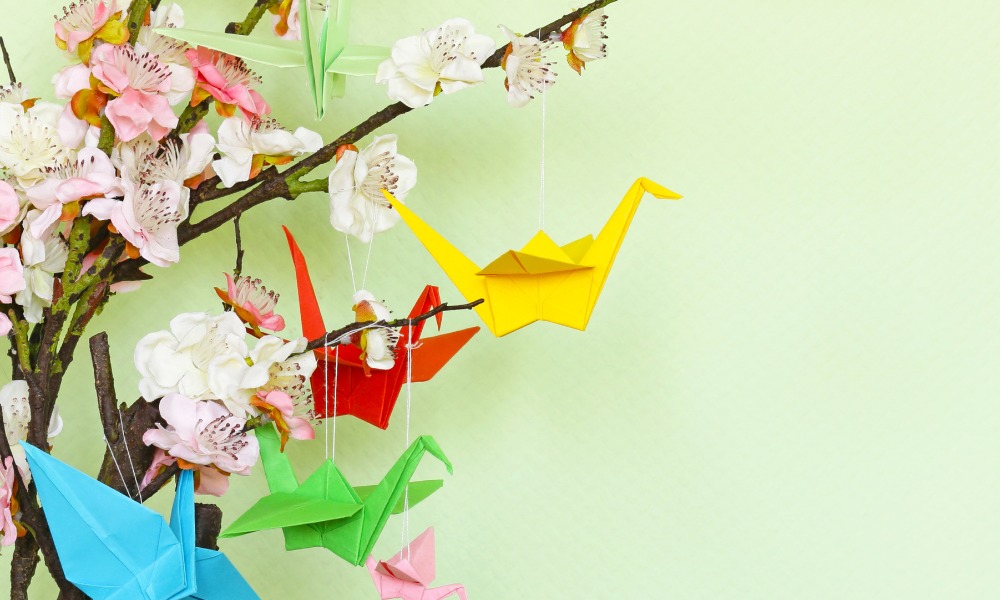The traditional art of Japan – origami, from an ancient recreational activity for adults and children to Japanese symbolic art, is now an apparent and indispensable matter in daily life.
The Definition of “Origami”
What is “origami”? Origami is derived from two kanji characters in Japanese, from the plain form “oru” (折る) which means “to fold” and “gami” or “kami” (紙) means “paper”. When combining two of them, we have “the act of folding paper” (折り紙). Today, origami is considered a part of crafting and designing. Also, it can be seen as a form of sculpture art with many different techniques and styles. And nowadays, origami can be applied to many other uses, not just for daily life but also for scientific benefits.
History of Origami
Origami has been in Japan’s history for a fairly long time, and the word “origami” has been recognized worldwide. Still, it wasn’t just started in Japan.
Even though there wasn’t any clear record of origami’s origin, it all began in the seventh century. Just as paper and paper-folding techniques were imported from China by Japanese Buddhist monks.
Furthermore, before the term “origami” became widely used later on in the twentieth century, “orikata”, “orisue” or “orimono” were used to describe “the act of folding”.

Credit: Photo AC
In each period in Japanese history, origami was used for different purposes. For instance:
In the Heian Period (794 – 1185), origami was an essential element of its people; origami was used to wrap gifts, decorate, and fold ornaments for various formal ceremonies.
Throughout the Muromachi Period (1338 – 1573), origami grew into a leisure activity of craft art for the elite at the samurai level.
And in the Edo Period (1603 – 1868), there was mass production of paper; therefore, origami became more accessible to ordinary people.
Gradually, origami has become a crucial part of Japanese cultural heritage, especially in the art and crafts aspect.
Different Types of Origami
There are various ways of making paper sculpture through origami, as the names of the techniques are pretty self-explanatory, such as: realistic (to create a model that is heavily based on real-life inspiration), minimal (to create a model as simple as you can), practical (to create a model for efficient uses), wet folding (a technique that created by Yoshizawa Akira, to create a model with water-soluble glue as a guide), and so many more.
Tools/Materials
After paper and paper-folding techniques were introduced to Japan, they were applied with Japanese materials to make a thin yet strong paper called washi (Japanese paper). Due to its durability, washi paper also was used for religious practices and official record-keeping.
Now, origami has widely developed into a leisure activity for people of all ages. Origami paper is still thin but less thick than the usual drawing paper, with either one blank side and one color/designed side or both sides having color/designed art.
Besides using your own hands to fold, we can also use a paper folding tool or a bone folder to help you smooth out edges and be precise with complicated patterns.

Credit: Photo AC
Origami in Daily Life
Other than being a leisure activity, origami can be seen in various aspects during the regular day-to-day routine. This technique has been mentioned previously, called the practical style of folding. For instance:
Calbee Chips Bag

Credit: picture by the author
With just a simple five-step instruction on the back of the Calbee chips bag, after we finish eating the chips, we can fold the bag into a smaller shape, which helps your trash bag be less messy and doesn’t take up too much space.
Chopsticks Cover

Credit: picture by the author
Another straightforward four-step instruction on the back of the chopstick cover, we can fold it into a chopstick holder, and of course, to help you hold your chopsticks.
Easy Origami Patterns for You to Try
After learning about the definition of origami, its history, and the basic materials to make simple models, let’s get into work and try these two basic patterns.
Paper Crane
The origami crane is one of the most famous models. Its design was based on the Japanese red-crowned crane.
Along with the rich history of the pattern, there is a myth from the old Japanese legend that if anyone folds a thousand paper cranes, they will be granted a wish from the gods.
And to make a paper crane is not too complicated to fold. As long as you have the patience and follow the instructions below, you can make an origami crane in no time.

Credit: picture by the author
Small Box
One more useful practical technique of origami you should try is the paper box. You can follow the instructions below to practice.

Credit: picture by the author
Will You Try Origami?
Origami might be a relaxing leisure activity, yet it’s also elegant in different aspects, as it will train your patience and precision. So grab some paper and try origami today!!!
Related Articles
- The Japanese Crane: What Does It Symbolise?
- Why Your Japan Bucket-List Should Include the Kabuki Experience!
- Weird Things in Japan That Just Make Sense
Featured photo credit: Canva.com






